2019 TOYOTA LAND CRUISER check oil
[x] Cancel search: check oilPage 17 of 624
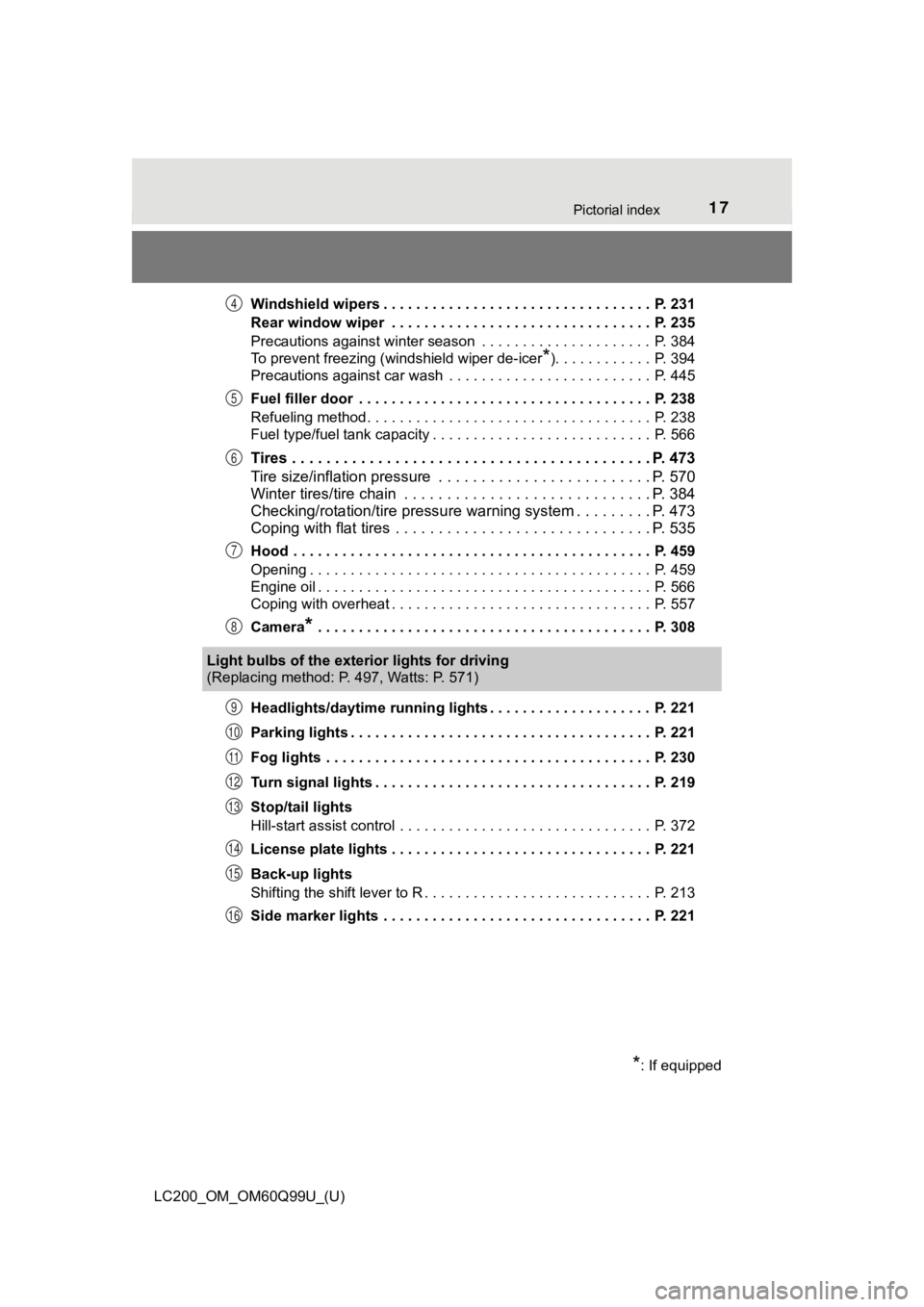
17Pictorial index
LC200_OM_OM60Q99U_(U)Windshield wipers . . . . . . . . . . . . . . . . . . . . . . . . . . . . . . . . . P. 231
Rear window wiper . . . . . . . . . . . . . . . . . . . . . . . . . . . . . . . . P. 235
Precautions against winter season . . . . . . . . . . . . . . . . . . . . . P. 384
To prevent freezing (windshield wiper de-icer
*). . . . . . . . . . . . P. 394
Precautions against car wash . . . . . . . . . . . . . . . . . . . . . . . . . P. 445
Fuel filler door . . . . . . . . . . . . . . . . . . . . . . . . . . . . . . . . . . . . P. 238
Refueling method . . . . . . . . . . . . . . . . . . . . . . . . . . . . . . . . . . . P. 238
Fuel type/fuel tank capacity . . . . . . . . . . . . . . . . . . . . . . . . . . . P. 566
Tires . . . . . . . . . . . . . . . . . . . . . . . . . . . . . . . . . . . . . . . . . . P. 473
Tire size/inflation pressure . . . . . . . . . . . . . . . . . . . . . . . . . P. 570
Winter tires/tire chain . . . . . . . . . . . . . . . . . . . . . . . . . . . . . P. 384
Checking/rotation/tire pressur e warning system . . . . . . . . .P. 473
Coping with flat tires . . . . . . . . . . . . . . . . . . . . . . . . . . . . . . P. 535
Hood . . . . . . . . . . . . . . . . . . . . . . . . . . . . . . . . . . . . . . . . . . . . P. 459
Opening . . . . . . . . . . . . . . . . . . . . . . . . . . . . . . . . . . . . . . . . . . P. 459
Engine oil . . . . . . . . . . . . . . . . . . . . . . . . . . . . . . . . . . . . . . . . . P. 566
Coping with overheat . . . . . . . . . . . . . . . . . . . . . . . . . . . . . . . . P. 557
Camera
* . . . . . . . . . . . . . . . . . . . . . . . . . . . . . . . . . . . . . . . . . P. 308
Headlights/daytime running lights . . . . . . . . . . . . . . . . . . . . P. 221
Parking lights . . . . . . . . . . . . . . . . . . . . . . . . . . . . . . . . . . . . . P. 221
Fog lights . . . . . . . . . . . . . . . . . . . . . . . . . . . . . . . . . . . . . . . . P. 230
Turn signal lights . . . . . . . . . . . . . . . . . . . . . . . . . . . . . . . . . . P. 219
Stop/tail lights
Hill-start assist control . . . . . . . . . . . . . . . . . . . . . . . . . . . . . . . P. 372
License plate lights . . . . . . . . . . . . . . . . . . . . . . . . . . . . . . . . P. 221
Back-up lights
Shifting the shift lever to R . . . . . . . . . . . . . . . . . . . . . . . . . . . . P. 213
Side marker lights . . . . . . . . . . . . . . . . . . . . . . . . . . . . . . . . . P. 221
4
5
6
7
8
Light bulbs of the exterior lights for driving
(Replacing method: P. 497, Watts: P. 571)
*: If equipped
9
10
11
12
13
14
15
16
Page 96 of 624
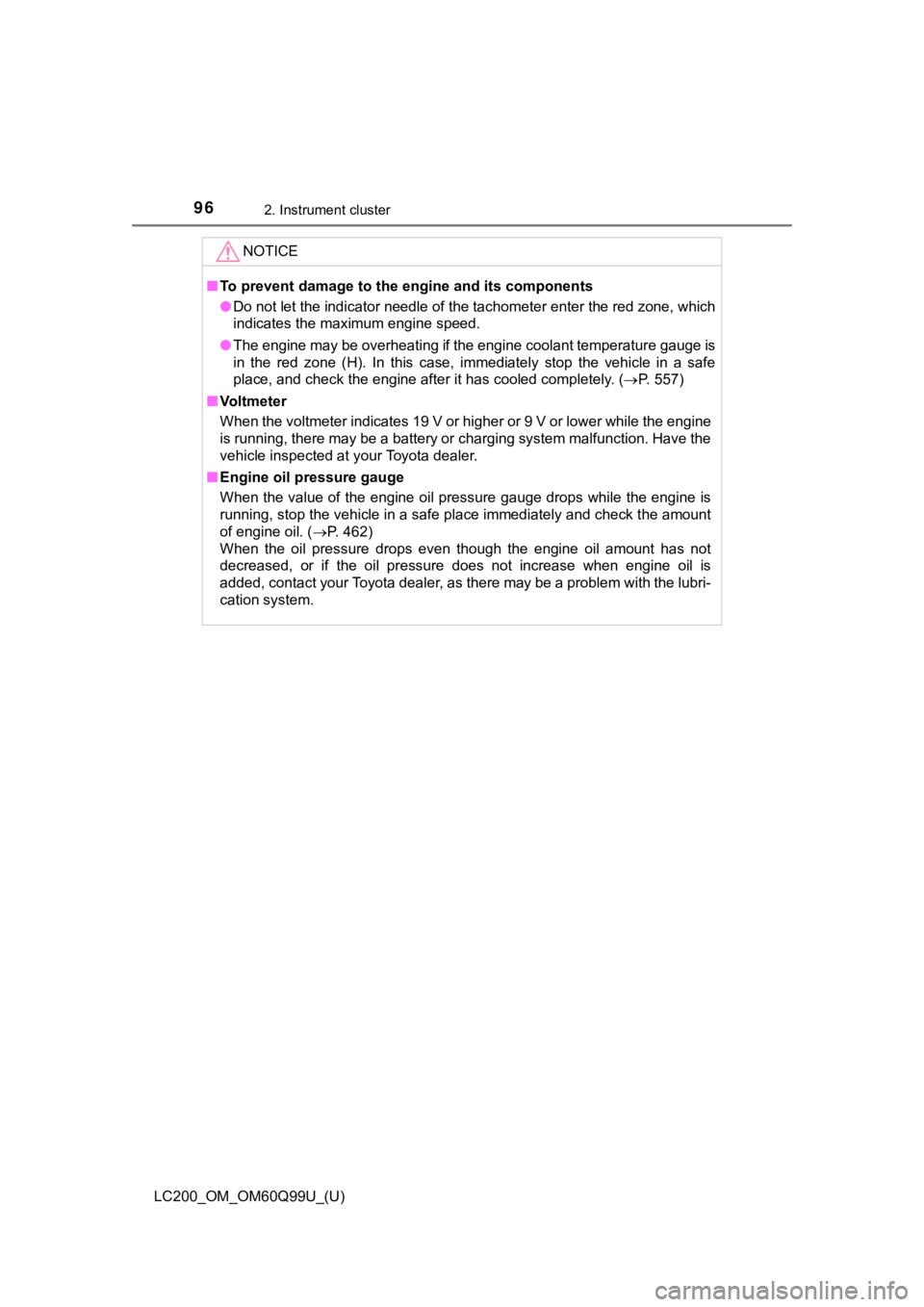
96
LC200_OM_OM60Q99U_(U)
2. Instrument cluster
NOTICE
■To prevent damage to the engine and its components
● Do not let the indicator needle of the tachometer enter the red zone, which
indicates the maximum engine speed.
● The engine may be overheating if the engine coolant temperature gauge is
in the red zone (H). In this case, immediately stop the vehicle in a safe
place, and check the engine after it has cooled completely. ( P. 557)
■ Vo l t m e t e r
When the voltmeter indicates 19 V or higher or 9 V or lower whi le the engine
is running, there may be a battery or charging system malfunction. Have the
vehicle inspected at your Toyota dealer.
■ Engine oil pressure gauge
When the value of the engine oil pressure gauge drops while the engine is
running, stop the vehicle in a safe place immediately and check the amount
of engine oil. ( P. 462)
When the oil pressure drops even though the engine oil amount h as not
decreased, or if the oil pressure does not increase when engine oil is
added, contact your Toyota dealer, as there may be a problem wi th the lubri-
cation system.
Page 182 of 624
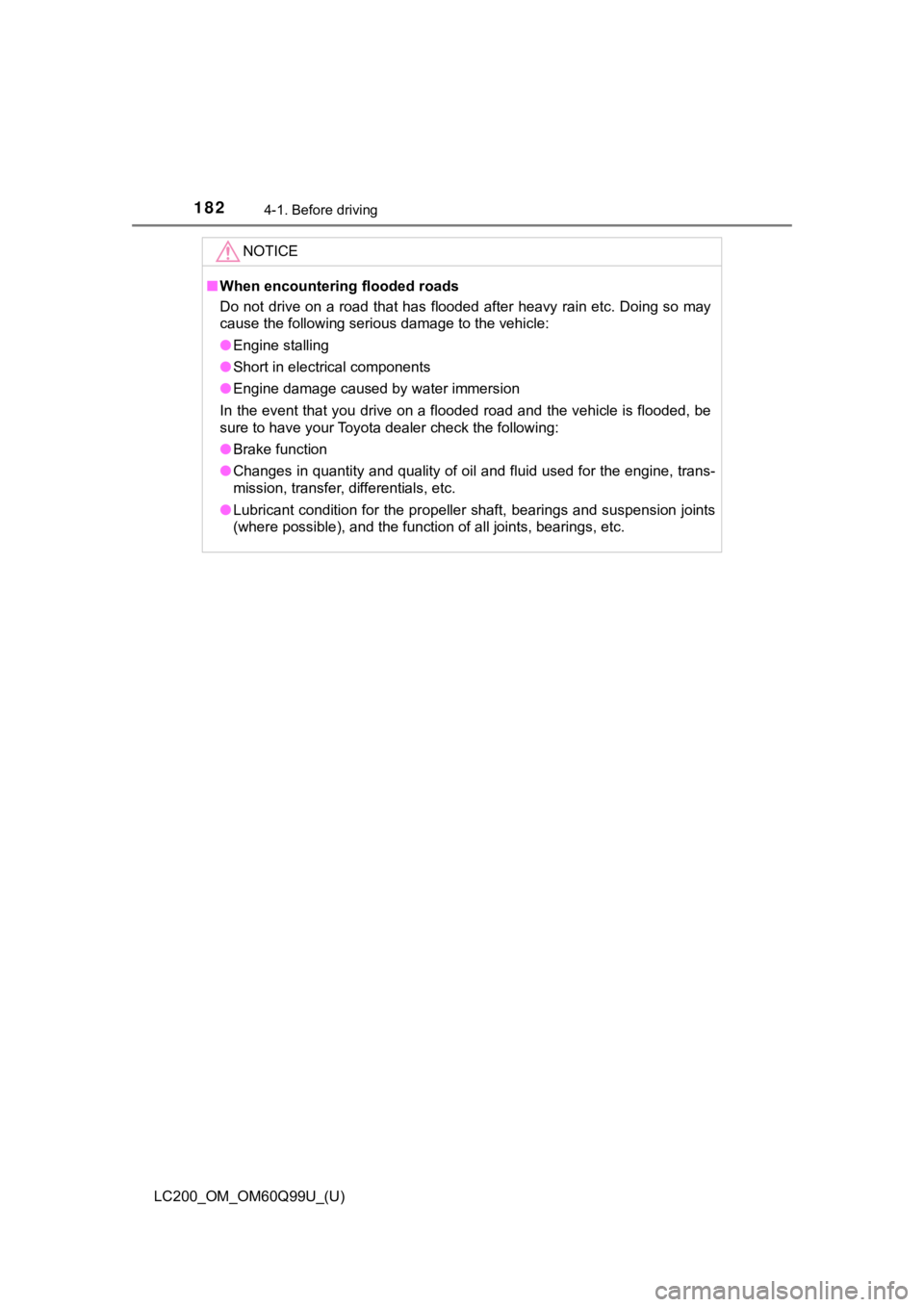
182
LC200_OM_OM60Q99U_(U)
4-1. Before driving
NOTICE
■When encountering flooded roads
Do not drive on a road that has flooded after heavy rain etc. D oing so may
cause the following serious damage to the vehicle:
● Engine stalling
● Short in electrical components
● Engine damage caused by water immersion
In the event that you drive on a flooded road and the vehicle i s flooded, be
sure to have your Toyota dealer check the following:
● Brake function
● Changes in quantity and quality of oil and fluid used for the engine, trans-
mission, transfer, differentials, etc.
● Lubricant condition for the propeller shaft, bearings and suspe nsion joints
(where possible), and the function of all joints, bearings, etc .
Page 383 of 624
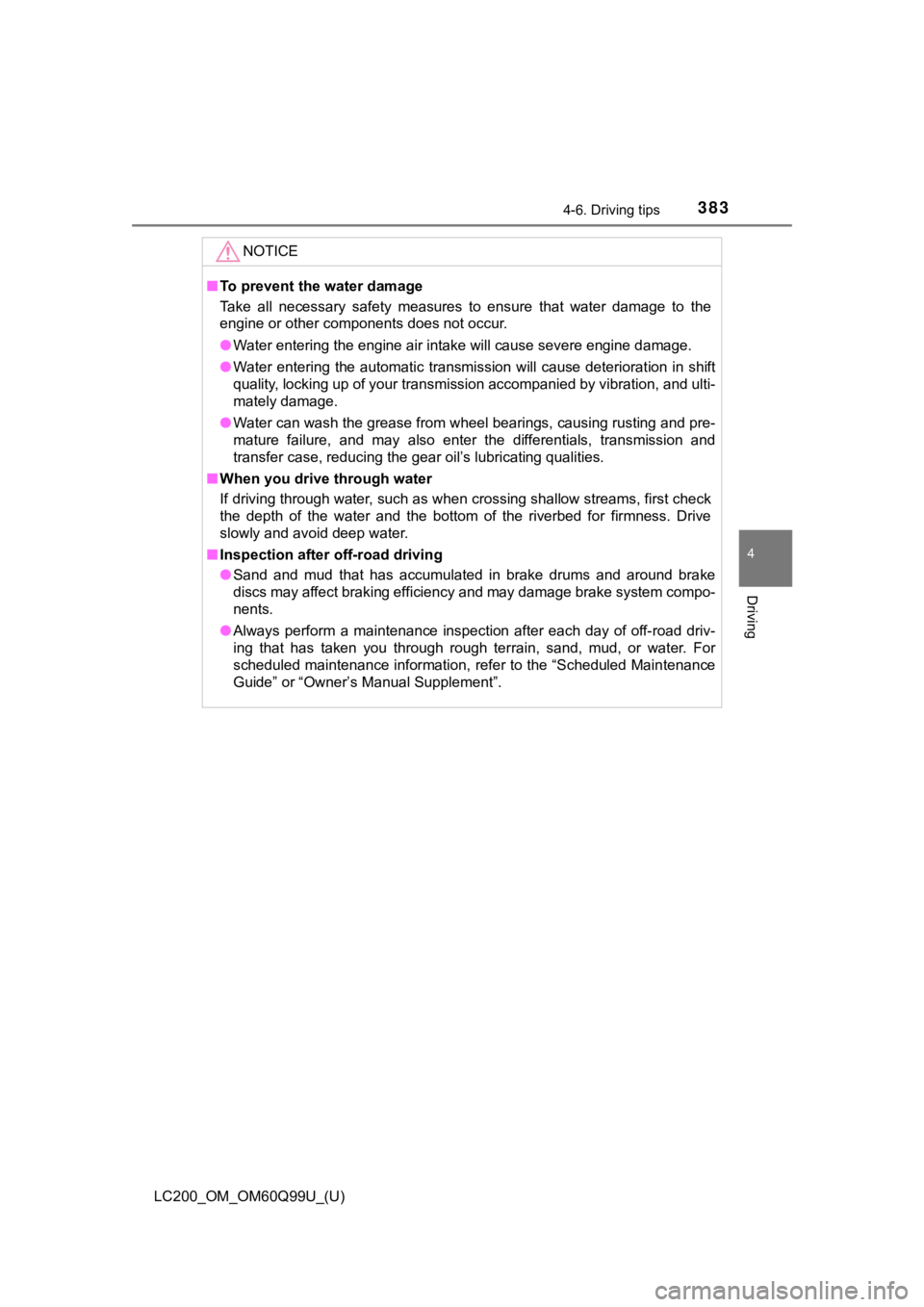
LC200_OM_OM60Q99U_(U)
3834-6. Driving tips
4
Driving
NOTICE
■To prevent the water damage
Take all necessary safety measures to ensure that water damage to the
engine or other components does not occur.
● Water entering the engine air intake will cause severe engine d amage.
● Water entering the automatic transmission will cause deteriorat ion in shift
quality, locking up of your transmission accompanied by vibrati on, and ulti-
mately damage.
● Water can wash the grease from wheel bearings, causing rusting and pre-
mature failure, and may also enter the differentials, transmission and
transfer case, reducing the gear oil’s lubricating qualities.
■ When you drive through water
If driving through water, such as when crossing shallow streams , first check
the depth of the water and the bottom of the riverbed for firmn ess. Drive
slowly and avoid deep water.
■ Inspection after off-road driving
● Sand and mud that has accumulated in brake drums and around bra ke
discs may affect braking efficiency and may damage brake system compo-
nents.
● Always perform a maintenance inspection after each day of off-r oad driv-
ing that has taken you through rough terrain, sand, mud, or wat er. For
scheduled maintenance information, refer to the “Scheduled Main tenance
Guide” or “Owner’s Manual Supplement”.
Page 384 of 624

384
LC200_OM_OM60Q99U_(U)
4-6. Driving tips
Winter driving tips
●Use fluids that are appropriate t o the prevailing outside tempera-
tures. • Engine oil
• Engine coolant
• Washer fluid
● Have a service technician inspec t the condition of the battery.
● Have the vehicle fitted with four snow tires or purchase a set of tire
chains for the rear tires.
Ensure that all tires are the same size and brand, and that cha ins match
the size of the tires.
Perform the following accordi ng to the driving conditions:
● Do not try to forcibly open a window or move a wiper that is fr ozen.
Pour warm water over the frozen area to melt the ice. Wipe away
the water immediately to prevent it from freezing.
● To ensure proper operation of the climate control system fan,
remove any snow that has accumulated on the air inlet vents in
front of the windshield.
● Check for and remove any excess ic e or snow that may have accu-
mulated on the exterior lights, vehicle’s roof, chassis, around the
tires or on the brakes.
● Remove any snow or mud from the bottom of your shoes before
getting in the vehicle.
Accelerate the vehicle slowly, keep a safe distance between you and
the vehicle ahead, and drive at a reduced speed suitable to roa d con-
ditions.
Carry out the necessary preparations and inspections before
driving the vehicle in winter. Always drive the vehicle in a ma n-
ner appropriate to the prevailing weather conditions.
Pre-winter preparations
Before driving the vehicle
When driving the vehicle
Page 444 of 624
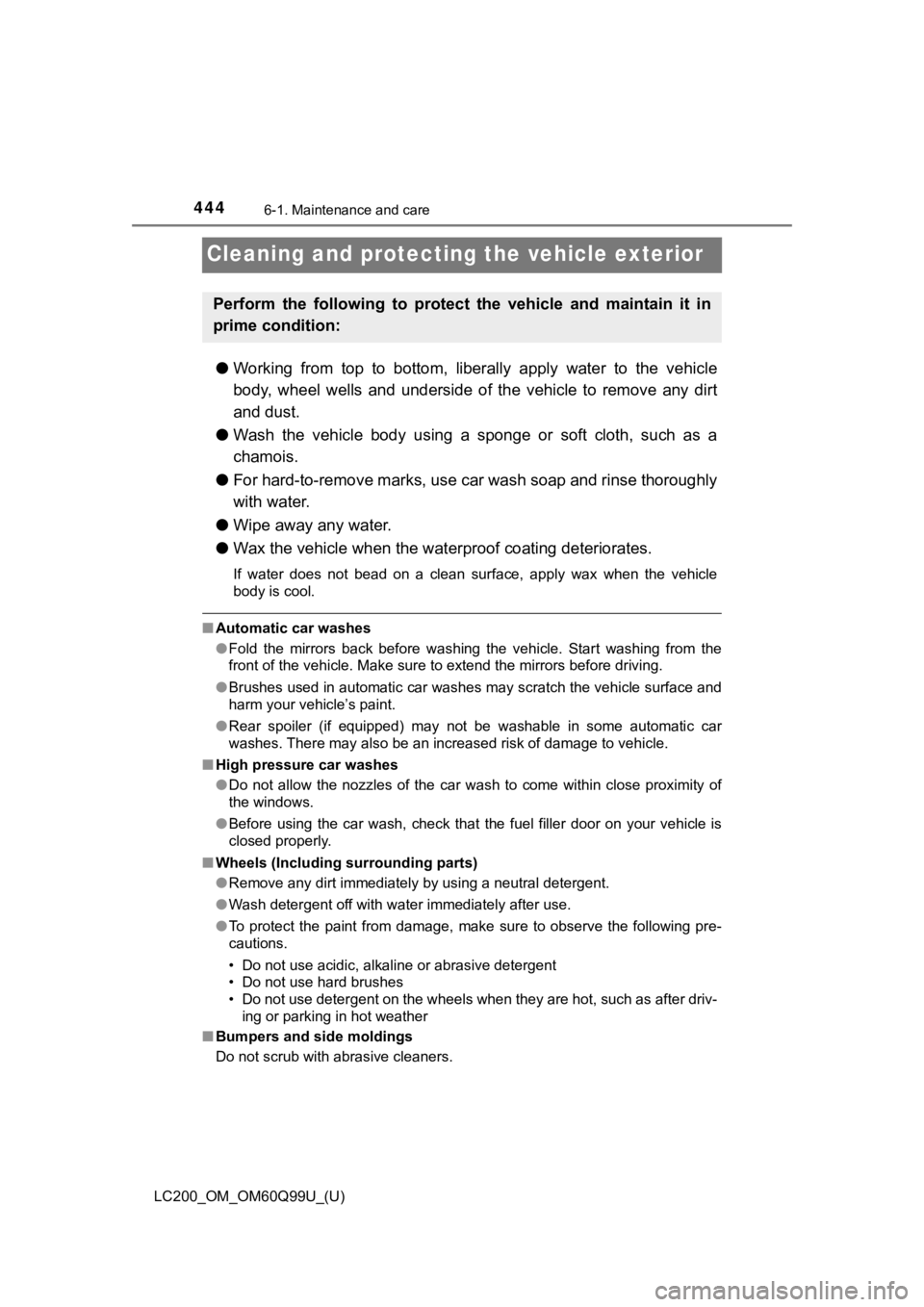
444
LC200_OM_OM60Q99U_(U)
6-1. Maintenance and care
Cleaning and protecting the vehicle exterior
●Working from top to bottom, liberally apply water to the vehicl e
body, wheel wells and underside of the vehicle to remove any di rt
and dust.
● Wash the vehicle body using a sponge or soft cloth, such as a
chamois.
● For hard-to-remove marks, use car wash soap and rinse thoroughl y
with water.
● Wipe away any water.
● Wax the vehicle when the wate rproof coating deteriorates.
If water does not bead on a clean surface, apply wax when the v ehicle
body is cool.
■ Automatic car washes
●Fold the mirrors back before washing the vehicle. Start washing from the
front of the vehicle. Make sure to extend the mirrors before dr iving.
● Brushes used in automatic car washes may scratch the vehicle su rface and
harm your vehicle’s paint.
● Rear spoiler (if equipped) may not be washable in some automati c car
washes. There may also be an increased risk of damage to vehicl e.
■ High pressure car washes
●Do not allow the nozzles of the car wash to come within close p roximity of
the windows.
● Before using the car wash, check that the fuel filler door on y our vehicle is
closed properly.
■ Wheels (Including surrounding parts)
●Remove any dirt immediately by using a neutral detergent.
● Wash detergent off with water immediately after use.
● To protect the paint from damage, make sure to observe the following pre-
cautions.
• Do not use acidic, alkaline or abrasive detergent
• Do not use hard brushes
• Do not use detergent on the wheels when they are hot, such as after driv-
ing or parking in hot weather
■ Bumpers and side moldings
Do not scrub with abrasive cleaners.
Perform the following to protect the vehicle and maintain it in
prime condition:
Page 453 of 624
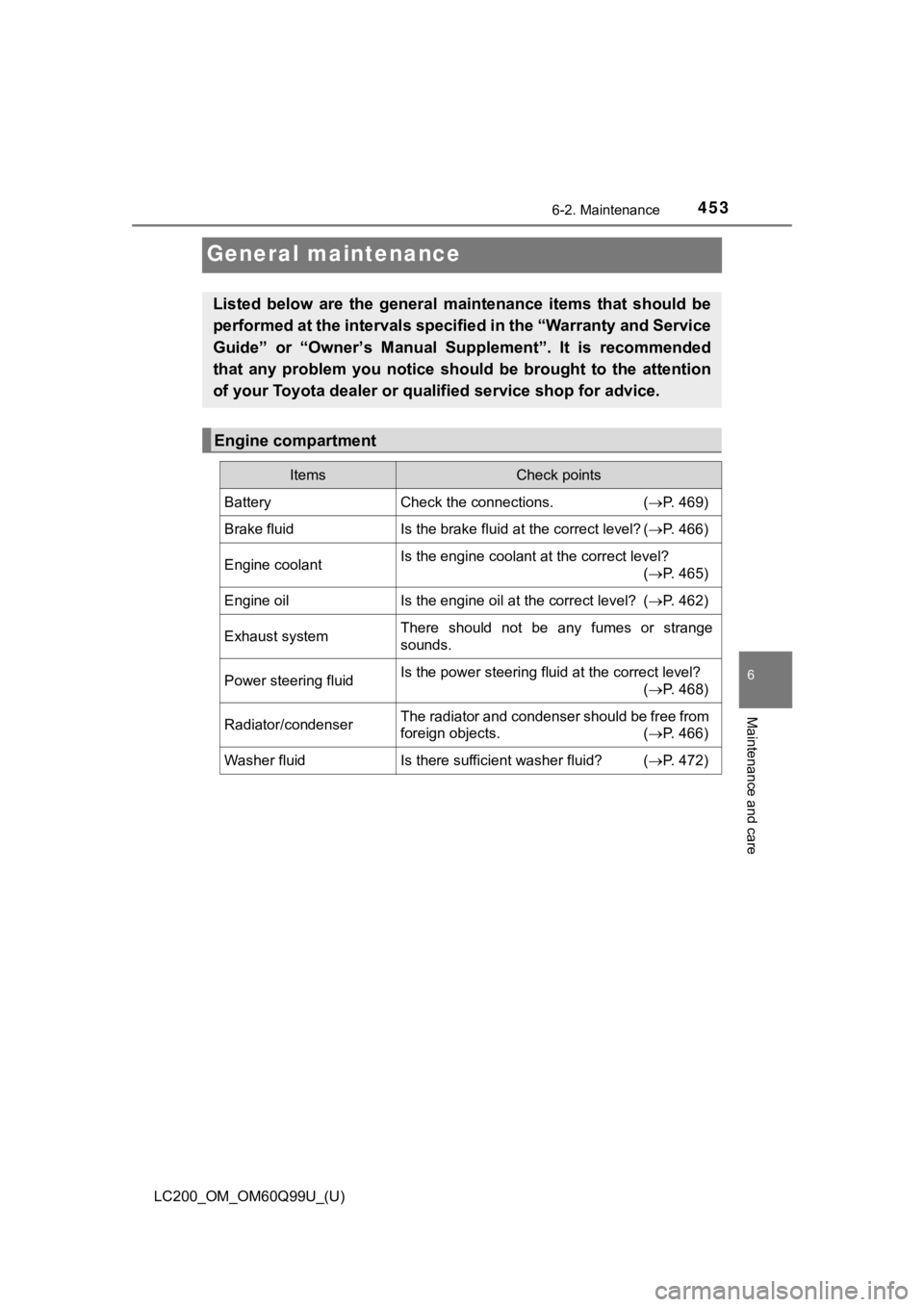
453
LC200_OM_OM60Q99U_(U)
6-2. Maintenance
6
Maintenance and care
General maintenance
Listed below are the general maintenance items that should be
performed at the intervals specified in the “Warranty and Service
Guide” or “Owner’s Manual S upplement”. It is recommended
that any problem you notice shoul d be brought to the attention
of your Toyota dealer or qualified service shop for advice.
Engine compartment
ItemsCheck points
BatteryCheck the connections. (P. 469)
Brake fluidIs the brake fluid at the correct level? ( P. 466)
Engine coolantIs the engine coolant at the correct level?
(P. 465)
Engine oilIs the engine oil at the correct level? ( P. 462)
Exhaust systemThere should not be any fumes or strange
sounds.
Power steering fluidIs the power steering fluid at the correct level?
(P. 468)
Radiator/condenserThe radiator and condenser should be free from
foreign objects. ( P. 466)
Washer fluidIs there sufficient washer fluid? (P. 472)
Page 462 of 624
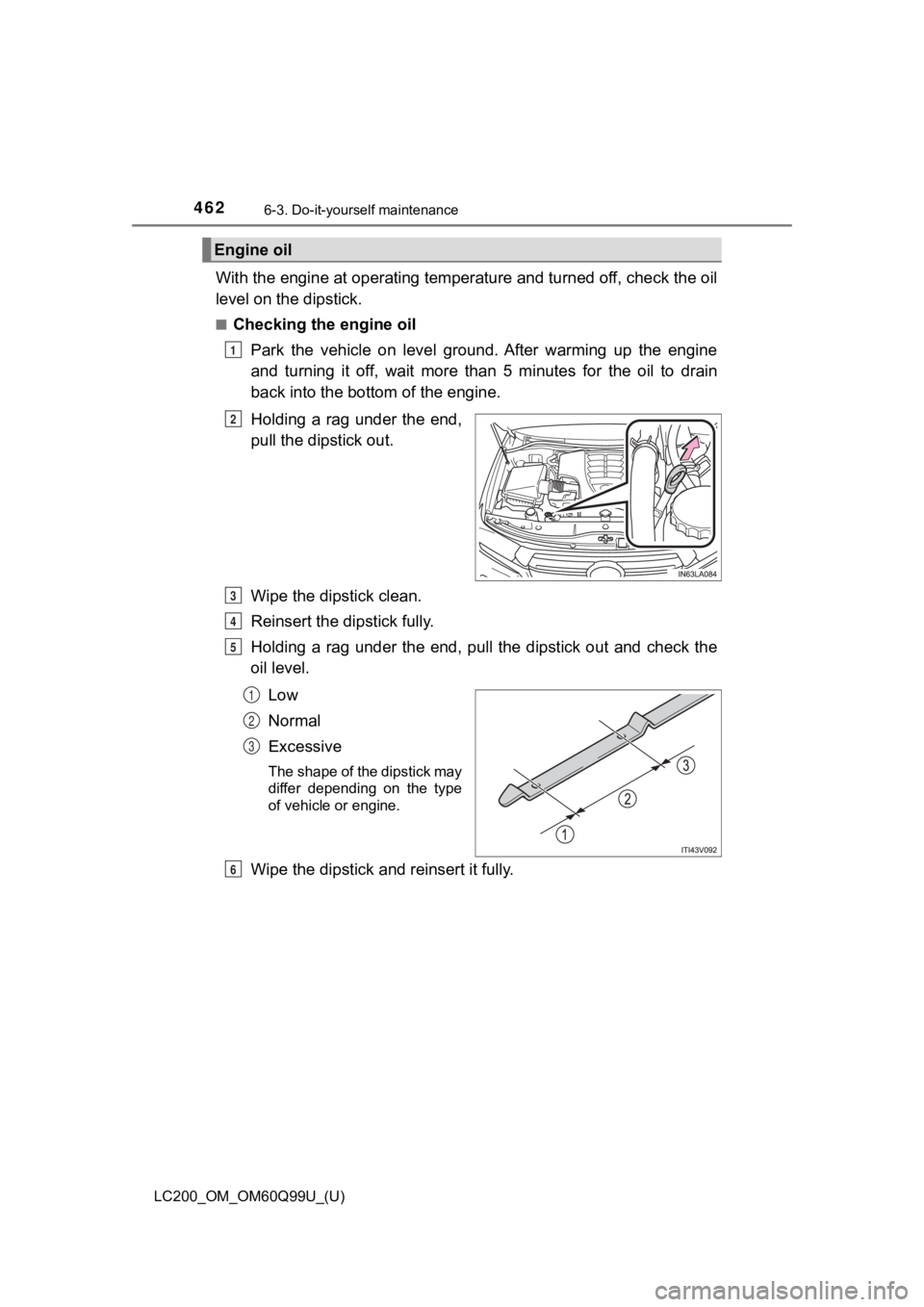
462
LC200_OM_OM60Q99U_(U)
6-3. Do-it-yourself maintenance
With the engine at operating temperature and turned off, check the oil
level on the dipstick.
■Checking the engine oil
Park the vehicle on level ground. After warming up the engine
and turning it off, wait more than 5 minutes for the oil to dra in
back into the bottom of the engine.
Holding a rag under the end,
pull the dipstick out.
Wipe the dipstick clean.
Reinsert the dipstick fully.
Holding a rag under the end, pull the dipstick out and check th e
oil level.
Low
Normal
Excessive
The shape of the dipstick may
differ depending on the type
of vehicle or engine.
Wipe the dipstick and reinsert it fully.
Engine oil
1
2
3
4
5
1
2
3
6